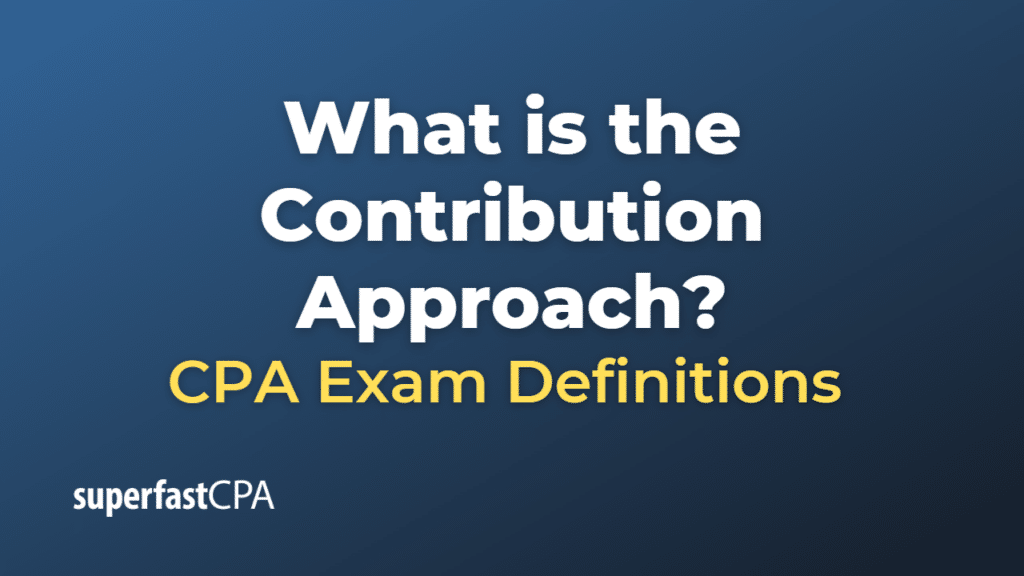Contribution Approach
The contribution approach, also known as the contribution margin approach, is a financial and management accounting method used to analyze the profitability and financial performance of a business. This approach focuses on the contribution margin, which is the difference between a company’s total sales revenue and its variable costs. The contribution margin represents the amount of money available to cover fixed costs and generate a profit.
The contribution approach is useful for:
- Assessing the profitability of individual products or services, as it helps identify which items generate the highest contribution margin and contribute most to covering fixed costs and generating profit.
- Making informed pricing decisions, as it helps businesses understand the impact of pricing changes on their contribution margin and overall profitability.
- Evaluating cost efficiency, as it highlights areas where variable costs can be reduced to improve the contribution margin and, ultimately, profitability.
- Supporting decisions related to product mix, as it helps businesses determine the optimal mix of products or services that maximize their contribution margin and overall profitability.
- Guiding decisions on resource allocation, as it helps businesses prioritize resources to focus on products or services with the highest contribution margin.
To calculate the contribution margin, use the following formula:
Contribution Margin = Total Sales Revenue – Total Variable Costs
The contribution margin can also be expressed on a per-unit basis or as a ratio:
Contribution Margin per Unit = Sales Price per Unit – Variable Cost per Unit
Contribution Margin Ratio = Contribution Margin / Total Sales Revenue
In summary, the contribution approach is a financial and management accounting method that focuses on the contribution margin to analyze a business’s profitability and financial performance. By examining the relationship between sales revenue, variable costs, and fixed costs, the contribution approach helps businesses make informed decisions related to pricing, product mix, cost efficiency, and resource allocation.
Example of the Contribution Approach
Let’s consider a hypothetical example involving a company that manufactures and sells two types of widgets: Widget A and Widget B.
Here is the cost and sales information for each widget:
- Widget A:
- Selling price per unit: $50
- Variable cost per unit: $30
- Monthly sales volume: 1,000 units
- Widget B:
- Selling price per unit: $80
- Variable cost per unit: $60
- Monthly sales volume: 500 units
Additionally, the company has $20,000 in monthly fixed costs.
First, let’s calculate the contribution margin for each widget:
Contribution Margin per Unit (Widget A) = $50 (price) – $30 (variable cost) = $20
Contribution Margin per Unit (Widget B) = $80 (price) – $60 (variable cost) = $20
Now, let’s calculate the total contribution margin for each widget:
Total Contribution Margin (Widget A) = $20 (contribution margin per unit) × 1,000 (units sold) = $20,000
Total Contribution Margin (Widget B) = $20 (contribution margin per unit) × 500 (units sold) = $10,000
Total Contribution Margin (Combined) = $20,000 (Widget A) + $10,000 (Widget B) = $30,000
Now we can calculate the company’s overall profitability:
Operating Income = Total Contribution Margin – Total Fixed Costs
Operating Income = $30,000 – $20,000 = $10,000
In this example, the contribution approach allows the company to analyze the profitability of each widget and their combined contribution to covering fixed costs and generating profit. Although both widgets have the same contribution margin per unit, Widget A generates a higher total contribution margin due to its higher sales volume.
Using the contribution approach, the company can make informed decisions related to pricing, product mix, cost efficiency, and resource allocation. For example, the company might consider increasing the sales volume of Widget B, as it has the same contribution margin per unit as Widget A, or exploring ways to reduce the variable costs associated with each widget to improve their contribution margins and overall profitability.












